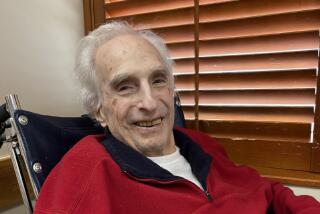A Hollywood Prince : SHOWMAN: The Life of David O. Selznick, <i> By David Thomson (Alfred A. Knopf: $35; 816 pp.)</i>
It is not given to most men to know the manner of their going, but David O. Selznick, who definitely was not most men, knew exactly what would happen after he was gone. “The obituaries will begin, ‘David O. Selznick, producer of “Gone With the Wind,” died today,’ ” he groused to associates, “and I’m trying like hell to rewrite them.”
While most Hollywood producers then and now would be content to be known as the power behind the most popular film ever made, this was not enough for D. O. S., the perfectionist who decided everything from whether Clark Gable would play Rhett Butler (he would) or noisy cellophane would be used to wrap the opening-night program (it wouldn’t).
The son of a failed movie mogul, the brother of a man who practically invented modern agenting, the son-in-law who also rose by marrying the daughter of the most powerful man in Hollywood, Selznick considered himself the premier moviemaker in the known world. Every project he put his hand to, he insisted (and there were many, from “Rebecca” and “A Star Is Born” to “Duel in the Sun” and “King Kong”), “is an attempt to be one of the outstanding pictures of the year.”
True, there were scoffers before the throne, people like Katharine Hepburn, more or less a Selznick discovery, who impishly compared him to a “beautifully designed and very expensive shoe--he wasn’t creative, but he was a piece of work.” But no matter. Selznick believed others yet unborn would be properly appreciative and--Sleeping Beauty awaiting Prince Charming’s kiss--he prepared for the moment carefully.
To begin with, Selznick apparently never threw out a piece of paper if he could help it: His personal and business archives ran to three million items, a full 57,000 pounds of material. Famous in his day and since for writing interminable, insistent memoranda (a fascinating fraction of which are collected in Rudy Behlmer’s “Memo From David O. Selznick”), he also got in the habit of producing lengthy manifestoes he never intended to send, only file. The reason, posits David Thomson, is that “somewhere in the advancing future, David saw his vindication resting in his archive--waiting for a biographer, perhaps the only person who would ever read all those memos.”
Thomson is that person, and in many ways he is as promising a rescuer as Selznick himself might wish for. A respected film critic and novelist, Thomson is a thoughtful and elegant writer, someone who understands both interpersonal dynamics and those of Hollywood. He has told Selznick’s story with five years’ worth of thoroughness, even mastering the wearing intricacies of the man’s often baffling business dealings.
Thomson’s book is quite a feat, and yet it finally ends up as obsessive, exasperating and exhausting as its subject. A trial to almost everyone he came in contact with while he was alive, Selznick has from beyond the grave performed the unfortunate trick of getting his biographer to lose patience with him as well.
Certainly there was enough in Selznick to frustrate a host of biographers. He was, as Thomson ably points out, an irritating mixture of qualities: arrogant as well as idealistic, incisive and sentimental, insecure and self-righteous. He was a nonstop womanizer, addicted to cigarettes and the artificial energizer Benzedrine, an incurable and elaborate present-giver, an indifferent father who simultaneously spoiled and neglected his children. “He was a mass of conflicting impulses,” said his astute first wife, Irene Mayer Selznick. “He wanted all ends as well as the middle.” His worst enemy, the only man who could ever stop him, was always himself.
In the most telling ways, Selznick was his father’s son. Lewis Selznick was one of those self-invented, self-destructive immigrants who helped create the movie business. Brash enough publicly to offer an unemployed Nicholas II a job after the 1917 revolution, he cared for nothing as much as he did his son David, not even the $10 million he was worth at one time. And, no matter how successful David got, those who knew him felt he “had never lost--or given up on--the role of a most adored and prized child.”
As much as Lewis loved David, that’s how much David adored the fledging film industry. “Humankind,” writes Thompson in a typically deft phrase, “took no form that pleased him more than that of audience.” Neglecting formal education the better to concentrate on the business, David had his own letterhead at age 14, was in charge of hundreds of employees when he was 18, and then, before he was 21, found himself out of work when his father’s bankrupt film company permanently collapsed.
Not much daunted, David went out to Hollywood, where his brother Myron was already established. Myron was shrewd, tough and professionally cynical, qualities that would lead both to an exceptional career as an agent (he was, for instance, the key to getting Vivien Leigh into “Gone With the Wind”) and to a fatal drinking problem. But David struck people differently. Unprepossessing, physically clumsy and with a middle initial of his own invention, he was nevertheless overflowing with energy, charm, idealism and infectious laughter--”an eager, alert St. Bernard,” remembers novelist Budd Schulberg, a sometime protege.
These qualities helped David not only to a job at MGM but also to the hand of the youngest daughter of the studio’s reigning lion, Louis B. Mayer. Selznick and Irene Mayer were married in 1930, in what Thomson calls “the most serious deal David would ever make.” She was small, dark, prudent and controlling; he was large, expansive and lavishly romantic. The marriage would produce a pair of sons and the kind of intricate psychodrama only the very different children of two strong-willed moguls could manufacture.
Though his energy gained him jobs, Selznick’s ambition made it difficult for him to keep them. He left MGM, went to work at Paramount, left that. In 1931, at age 29, he became head of West Coast production for RKO, where he had a hand in “King Kong,” helped launch Hepburn and director George Cukor, pushed for the signing of Fred Astaire and encouraged Max Steiner to change the face of modern movie scores.
Still, it wasn’t enough. A desperate seeker after perfection in a notoriously pragmatic business, Selznick yearned to be in a position well-funded enough to allow him to concentrate obsessively on one film at a time without having to bother with the smaller fry that paid the bills. When, in 1936, he joined forces with Jock Whitney, one of the wealthiest men in America, and formed Selznick International, it seemed his dream had come true.
And, for the space of one legendary film, it had. For it was Selznick International that produced “Gone With the Wind” and seemed to validate David’s particular brand of auteurism, which held that no actor, no director, certainly no writer, was as important to a David O. Selznick picture as D. O. S. himself.
On “Gone With the Wind,” all Selznick’s bad habits had happy endings. A terrible administrator and world-class meddler, his dithering led to a three-year gestation period for the film, which served only to whet the public’s appetite. Persuaded that he could write as well as any screenwriter, and not shy about demonstrating it, Selznick changed writers like shirts until he got what he wanted. Stubborn enough to believe in his dream even if it cost a then-unheard-of $4.25 million and ran 220 minutes, he was more than vindicated in the end.
But that success, the nation-wide pandemonium at the box office, the record eight Oscars, including best picture, the international acclaim proved to be the undoing of Selznick as much as the making of him. Confirmed in all his worst traits, he came to believe, Thomson says, that “it was now beneath his consideration to make anything like an ordinary picture.” Not that he didn’t continue to be sporadically productive; he raided Europe, for instance, and almost simultaneously brought over Alfred Hitchcock to do “Rebecca” and Ingrid Bergman to star in “Intermezzo.” But his personal drama now began to outweigh what he did on the screen.
Always a passionate gambler, his losses between 1945 and 1947 totaled over a million dollars. Fiscal ineptitude lost him the rights to “Gone With the Wind,” and he lost Irene as well when he became infatuated with a young actress named Phyllis Isley, changed her name to Jennifer Jones, both made and unmade her career and turned her into his second unhappy wife. By the time he died in 1965, Selznick had in common with many another unproductive producer “no other real calling except trying to look prosperous and keeping the grin fixed on their faces.”
This is a dizzying story, and for the most part Thompson tells it well, mixing unusually fine writing with interviews from almost everyone left living (with the notable exception of Jennifer Jones). But, like Selznick himself, the problems here are almost as great as the accomplishments.
For one thing, Thomson seems to have written this book as a corrective to more forthrightly admiring looks at Selznick, such as Ronald Haver’s “David O. Selznick’s Hollywood,” which calls him “the most important figure in American films after D. W. Griffith.” As a result, he shortchanges details of Selznick’s achievements (what James Agee called his “blend of serious talent with smart, safe showmanship”) in a way that will make newcomers to the story wonder what the fuss is about.
“Showman’s” biggest problem, however, is that Thomson is seriously lacking in sympathy for his subject. As the pages go on, he allows himself to get increasingly exasperated with Selznick, calling him “a great spoiled boy,” lamenting “one more piece of monstrous egotism” and “tireless deviousness” by a man “buried in his own neuroses.”
Clearly, David O. Selznick made a career out of getting on people’s nerves, and while a biographer certainly need not approve of him, to do the man justice he must be approached with empathy and dispassion, not unremitting censure. “I came to love him,” Thomson says of David O. Selznick on the very last page of this very long book, an unlikely sentiment which, even if believable, has come too little and too late to make any difference.
More to Read
Only good movies
Get the Indie Focus newsletter, Mark Olsen's weekly guide to the world of cinema.
You may occasionally receive promotional content from the Los Angeles Times.











